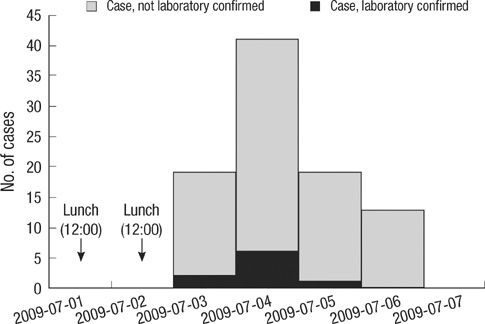J Korean Med Sci.
2010 Nov;25(11):1595-1600. 10.3346/jkms.2010.25.11.1595.
Epidemiology of Campylobacter jejuni Outbreak in a Middle School in Incheon, Korea
- Affiliations
-
- 1Department of Gastroenterology, Ajou University School of Medicine, Suwon, Korea. dubogi@hanmail.net
- 2Department of Pediatrics, Gachon University of Medicine and Science, Incheon, Korea.
- 3Incheon Metropolitan Government Research Institute of Public Health and Environment, Incheon, Korea.
- 4Division of Epidemiologic Investigation, Department of Infectious Disease Control, Center for Disease Control and Prevention, Seoul, Korea.
- KMID: 1779229
- DOI: http://doi.org/10.3346/jkms.2010.25.11.1595
Abstract
- On July 6, 2009, an outbreak of gastroenteritis occurred among middle school students in Incheon. An investigation to identify the source and describe the extent of the outbreak was conducted. A retrospective cohort study among students, teachers, and food handlers exposed to canteen food in the middle school was performed. Using self-administered questionnaires, information was collected concerning on symptoms, days that canteen food was consumed, and food items consumed. Stool samples were collected from 66 patients and 11 food handlers. The catering kitchen was inspected and food samples were taken. Of the 791 people who ate canteen food, 92 cases became ill, representing an attack rate of 11.6%. Thirty-one (40.3%) of the 77 stool specimens were positive for Campylobacter jejuni. Interviews with kitchen staff indicated the likelihood that undercooked chicken was provided. This is the first recognized major C. jejuni outbreak associated with contaminated chicken documented in Korea.
Keyword
MeSH Terms
-
Adolescent
Adult
Animals
Campylobacter Infections/*epidemiology
*Campylobacter jejuni
Chickens
Cohort Studies
*Disease Outbreaks
Electrophoresis, Gel, Pulsed-Field
Environmental Exposure
Female
Food Contamination
Humans
Male
Middle Aged
Questionnaires
Republic of Korea
Retrospective Studies
Risk Factors
Water Microbiology
Figure
Cited by 3 articles
-
Campylobacter jejuni Foodborne Infection Associated with Cross-contamination: Outbreak in Seoul in 2017
Cho Ryok Kang, Ji Hwan Bang, Sung-Il Cho
Infect Chemother. 2019;51(1):21-27. doi: 10.3947/ic.2019.51.1.21.Experience of Campylobacter gastroenteritis in Korean children: Single-center study
Seung Hyeon Seo, Yeoun Joo Lee, Sang Wook Mun, Jae Hong Park
Kosin Med J. 2018;33(2):150-158. doi: 10.7180/kmj.2018.33.2.150.An Outbreak of Campylobacter Jejuni Involving Healthcare Workers Detected by COVID-19 Healthcare Worker Symptom Surveillance
Hye Jin Shi, Jae Baek Lee, Shinhee Hong, Joong Sik Eom, Yoonseon Park
Korean J Healthc Assoc Infect Control Prev. 2023;28(1):172-177. doi: 10.14192/kjicp.2023.28.1.172.
Reference
-
1. Wilson DJ, Gabriel E, Leatherbarrow AJ, Cheesbrough J, Gee S, Bolton E, Fox A, Fearnhead P, Hart CA, Diggle PJ. Tracing the source of campylobacteriosis. PLoS Genet. 2008. 4:e1000203.
Article2. Zia S, Wareing D, Sutton C, Bolton E, Mitchell D, Goodacre JA. Health problems following Campylobacter jejuni enteritis in a Lancashire population. Rheumatology (Oxford). 2003. 42:1083–1088.
Article3. Gillespie IA, O'Brien SJ, Frost JA, Adak GK, Horby P, Swan AV, Painter MJ, Neal KR. Campylobacter Sentinel Surveillance Scheme Collaborators. A case-case comparison of Campylobacter coli and Campylobacter jejuni infection: a tool for generating hypotheses. Emerg Infect Dis. 2002. 8:937–942.4. Adak GK, Meakins SM, Yip H, Lopman BA, O'Brien SJ. Disease risks from foods, England and Wales, 1996-2000. Emerg Infect Dis. 2005. 11:365–372.
Article5. Said B, Wright F, Nichols GL, Reacher M, Rutter M. Outbreaks of infectious disease associated with private drinking water supplies in England and Wales 1970-2000. Epidemiol Infect. 2003. 130:469–479.
Article6. French N, Barrigas M, Brown P, Ribiero P, Williams N, Leatherbarrow H, Birtles R, Bolton E, Fearnhead P, Fox A. Spatial epidemiology and natural population structure of Campylobacter jejuni colonizing a farmland ecosystem. Environ Microbiol. 2005. 7:1116–1126.
Article7. Kim JS. Approaching step and method in epidemiologic study. Principle of epidemiology. 2000. 5th ed. Seoul: Schinkwang;226–230.8. Wingstrand A, Neimann J, Engberg J, Nielsen EM, Gerner-Smidt P, Wegener HC, Mølbak K. Fresh chicken as main risk factor for campylobacteriosis, Denmark. Emerg Infect Dis. 2006. 12:280–285.
Article9. Friedman CR, Hoekstra RM, Samuel M, Marcus R, Bender J, Shiferaw B, Reddy S, Ahuja SD, Helfrick DL, Hardnett F, Carter M, Anderson B, Tauxe RV. Risk factors for sporadic Campylobacter infection in the United States: A case-control study in FoodNet sites. Clin Infect Dis. 2004. 38:Suppl 3. S285–S296.10. Stafford RJ, Schluter P, Kirk M, Wilson A, Unicomb L, Ashbolt R, Gregory J. A multi-centre prospective case-control study of campylobacter infection in persons aged 5 years and older in Australia. Epidemiol Infect. 2007. 135:978–988.
Article11. Danis K, Di Renzi M, O'Neill W, Smyth B, McKeown P, Foley B, Tohani V, Devine M. Risk factors for sporadic Campylobacter infection: an all-Ireland case-control study. Euro Surveill. 2009. 14:19123.
Article12. Stern NJ, Kotula AW. Survival of Campylobacter jejuni inoculated into ground beef. Appl Environ Microbiol. 1982. 44:1150–1153.
Article13. Karmali MA, Fleming PC. Campylobacter enteritis. Can Med Assoc J. 1979. 120:1525–1532.14. Jakopanec I, Borgen K, Vold L, Lund H, Forseth T, Hannula R, Nygård K. A large waterborne outbreak of campylobacteriosis in Norway: the need to focus on distribution system safety. BMC Infect Dis. 2008. 8:128.
Article15. Rautelin H, Jusufovic J, Hanninen ML. Identification of hippurate-negative thermophilic campylobacters. Diagn Microbiol Infect Dis. 1999. 35:9–12.
Article16. Nayak R, Stewart TM, Nawaz MS. PCR identification of Campylobacter coli and Campylobacter jejuni by partial sequencing of virulence genes. Mol Cell Probes. 2005. 19:187–193.
Article17. Denis M, Soumet C, Rivoal K, Ermel G, Blivet D, Salvat G, Colin P. Development of a m-PCR assay for simultaneous identification of Campylobacter jejuni and C. coli. Lett Appl Microbiol. 1999. 29:406–410.
Article18. Al Amri A, Senok AC, Ismaeel AY, Al-Mahmeed AE, Botta GA. Multiplex PCR for direct identification of Campylobacter spp. in human and chicken stools. J Med Microbiol. 2007. 56:1350–1355.
Article
- Full Text Links
- Actions
-
Cited
- CITED
-
- Close
- Share
- Similar articles
-
- An Outbreak of Campylobacter Jejuni Involving Healthcare Workers Detected by COVID-19 Healthcare Worker Symptom Surveillance
- A Case of Campylobacter jejuni Enterocolitis with Acute Pancreatitis and Hemolytic Uremic Syndrome
- Campylobacter jejuni Foodborne Infection Associated with Cross-contamination: Outbreak in Seoul in 2017
- Campylobacter jejuni Bacteremia in a Healthy Child
- A Septic Abortion Caused by Campylobacter jejuni bacteremia



